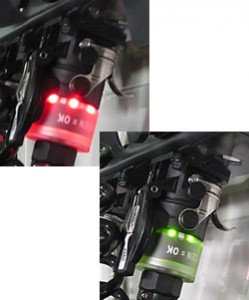Using the TrailerCheck II With Code Reader
Before plugging the Code Reader in to the trailers ECU, make sure the Trailer & Code Reader are powered down. This reduces attempted incorrect cable connections and of powering incorrect circuits.
Included in the kit are 3 Connectors:
1 – Wabco & Knorr Bremese
2 – Haldex Modular
3 – Haldex Modal
ECU Connection
Check the ECU connector on the trailer casing, this connector can be found damaged and corroded, if so do not attempt to plug the associated cable link as you could cause damage.
Once connected to the ECU, power up the trailer by pressing the RED ISO CAN Line button of the TrailerCheck operator panel. Make sure all connections are good and turn on the Code Reader, scroll to the required menu e.g. Haldex. Then scroll by pressing the right or left arrow buttons to the required info, e.g. Read Fault Codes.
You can now read ACTIVE fault codes & a description, for further codes scroll forward.
Once an active fault code has been removed this will move into the Stored Fault Code.
Within a Haldex system codes must be fixed before further codes are viewed.
Haldex systems show 5 codes at a time in the stored or active code areas.
Once all codes have been reviewed and also recorded, exit and scroll to clear fault codes. Then clear all codes.
Return to Stored codes to check ECU memory is clear.
Once completed turn off the Code Reader and TrailerCheck before you remove the ECU cable from the trailer.
Charging The TrailerCheck
To mains charge again first connect the charger to the TrailerCheck and then plug into the mains. The charger is a three stage device, green will first be lit briefly to indicate battery sate, red will indicate batteries are receiving charge, orange indicates almost charged and green indicates fully charged and then trickle charging if left connected.
To use the accessory power for a lead light etc, remove the lead from the lid of the case and then CLOSE THE CASE and clip shut to switch the TrailerCheck off. Then put the 4 pin plug into the case socket and use the cigar lighter socket adaptor for any accessories. (Not included in standard case).
If the case emits a double bleeping sound when in operation or closed the batteries are low and the TrailerCheck requires recharging!
Trailer Cables
TrailerCheck has 3 cables connected to the inner case, you can identify each cable by…
Cable with the clamp – This is the ISO ABS / EBS cable
Black cable with no white front face – This is the main lighting circuit cable
Black cable with a white face – This is the secondary cable
Contact aide automotive for further info.

